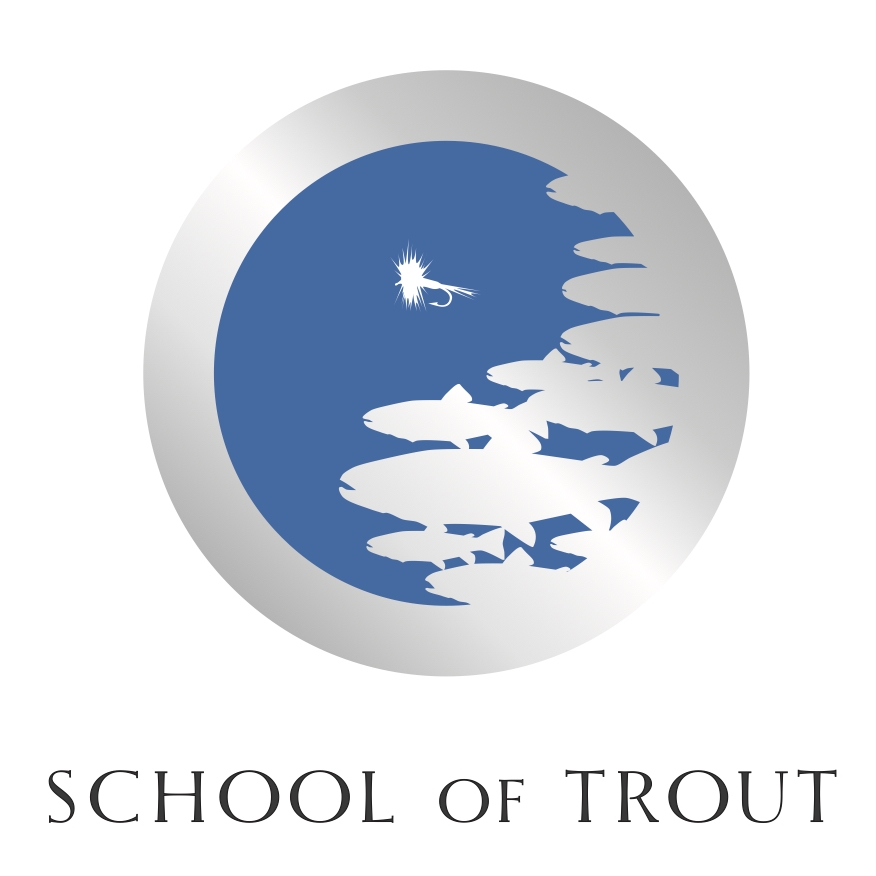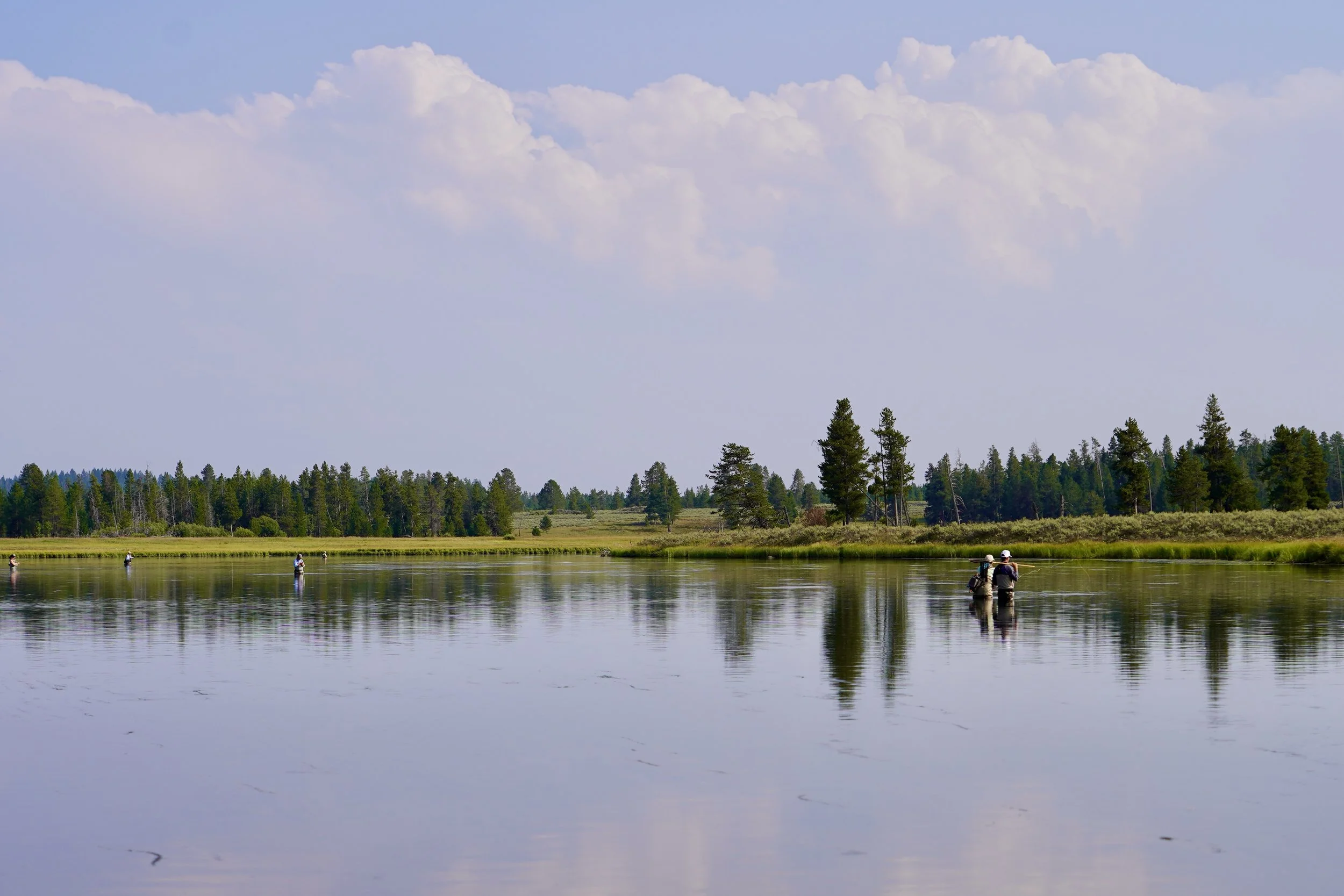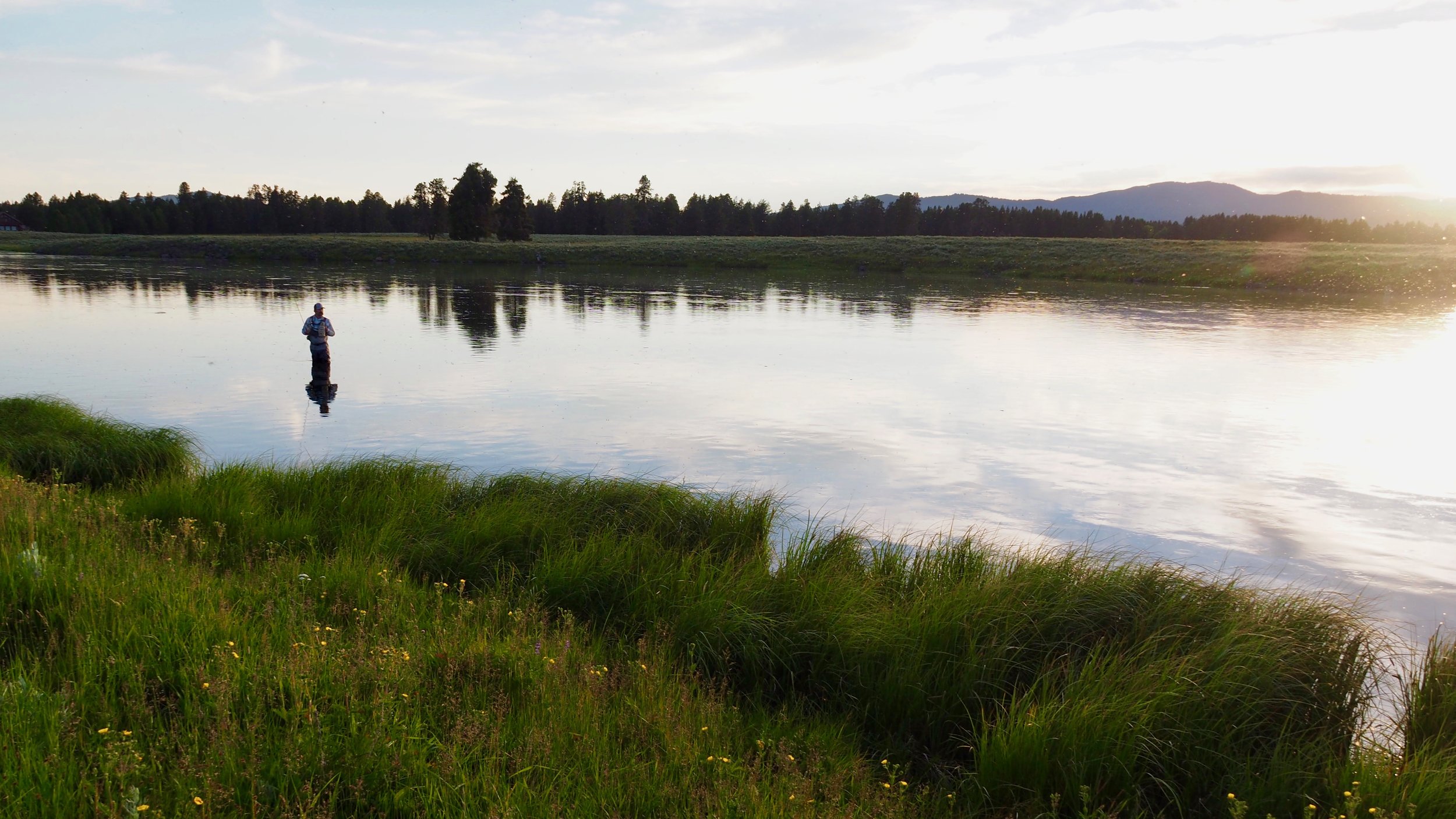THE TAO OF TROUT Student Information
Here’s everything you need to know as you prepare for SOT’S The Tao of Trout class in Idaho.
Location
Our 2025 Tao of Trout class will be held at TroutHunter on the Henry’s Fork. TroutHunter is located in the small community of Last Chance, Idaho. The physical address is 3327 North U.S. Hwy 20, Island Park, Idaho 83429. The Henry’s Fork, one of the most famous trout fisheries in the world, flows right by the lodge. You’ll have a view of the river from your room.
For those who aren’t familiar with the area, the Henry’s Fork is near the southwestern edge of Yellowstone National Park. It’s about 35 minutes (by car) from West Yellowstone, MT, approximately 40 minutes from the Madison River near Slide Inn, MT, and about 25 minutes from Ashton, ID. The Henry’s Fork is in the heart of the Rocky Mountains, with views of the Centennial Range and the Tetons.
Dates & Times
The class starts on Sunday, October 5th and ends on Saturday, October 11th. We suggest that students do their best to arrive between 3:00 pm and 4:30 pm on Sunday the 5th. We’ll have a “meet & greet” hour from 5:30 pm to 6:30 pm. Dinner will start around 6:30 pm, and it will be followed by a short introduction to the class and our opening program.
We will wrap up the class at approximately 11am on Saturday, October 11th.
Travel
We recommend that attendees fly into Idaho Falls, Idaho (IDA), then rent a car for the 1 hour and 15 minute drive to TroutHunter. Other options include West Yellowstone, Montana (WYS), which is a 40 minute drive; Jackson Hole, Wyoming (JAC), a 2 hour and 15 minute drive; Bozeman, Montana (BZN), a 2 hours and 30 minute drive; and Salt Lake City, Utah (SLC) which is 4 hours and 30 minutes.
If you’d prefer to take an airport shuttle from Idaho Falls, they are available via the Yellow Sally Shuttle Service.
We will also run one shuttle from the Idaho Falls airport on the Sunday afternoon when students arrive, as well as the Saturday that students depart. If you’d like to avail yourself of the SOT shuttle, please let us know well in advance.
Finally, we suggest that anyone coming in from the East Coast, or from another country, gives strong consideration to flying into the Greater Yellowstone area a day early. Given the prevalence of flight delays, and flight cancelations, we believe that allowing a little extra time on the front end could prove to be helpful. We’ve had students miss their first day of class because of airline delays and cancellations. Traveling early can help minimize that risk.
DIRECTIONS
TroutHunter, which is at 3327 North U.S. Hwy 20, is on the west side of the highway in the Last Chance section of Island Park, Idaho. If you’re driving in from the south, TroutHunter will be on your left. If you’re driving in from the north, TroutHunter will be on your right.
Check In
When you arrive at TroutHunter, please park in the parking lot and walk into the fly shop, which is to the right of the main dining room entrance. A TroutHunter employee will check you in, give you your room key and direct you to your room. A School of Trout staff member will be on hand to welcome you.
TAB
During the check-in process, TroutHunter will open a tab in your name. TroutHunter has an excellent fly shop. You can put any purchases, as well as your fishing license and any gratuities for the TroutHunter staff, on your tab. If you do decide to run a tab, please remember to settle up before you leave.
Fishing License
We suggest that you purchase your license online before you arrive at the School of Trout. (Please make sure that your license covers the dates you will be at the class.) If you’d prefer to pick up your Idaho fishing license at TroutHunter, you can do that when you check in.
Clothing
It’s impossible to predict the exact weather or temperatures we’ll experience on the Henry’s Fork in early-to-mid October. We recommend that you pack for a wide variety of conditions, with the most likely being cool mornings, warmer afternoons, and cool evenings. That means everything from lighter shirts and pants to rain gear and warm jackets. We recommend that you consider clothing from reputable manufacturers like Orvis, Patagonia and Simms, and that you steer clear of cotton. Oh, and warm, high quality wool socks and warm pants are a must for under your waders. (We will not be wet-wading on the Henry’s Fork in October.)
If you have specific questions, or if you’d like our personal recommendations on appropriate clothing items, please drop us a note.
On the chance it might prove helpful, here’s a basic minimalist clothing list for the Henry’s Fork. (In general, it’s better to pack a little too heavy than a little too light, so consider the list below to be the minimum you should bring.)
Three medium-weight shirts and three medium-weight pairs of pants and/or shorts. (Synthetic rather than cotton.)
Underwear for your stay.
Three or four pairs of heavyweight wool socks.
Three pairs of lightweight wool or synthetic socks.
Lightweight synthetic long johns.
Heavyweight synthetic long johns.
Three comfortable synthetic fishing shirts or fishing hoodies.
Two pairs of synthetic fishing pants.
One pair of heavy fleece pants or insulated under-wader pants.
One medium-weight fleece jacket or pull-over.
One heavy-weight fleece or puffy jacket.
One rain jacket. (Make sure you bring a rain jacket that’s designed to be worn over waders.)
One fishing hat.
One warm hat.
Gloves.
Warm, comfortable, water-resistant shoes or boots.
Fishing Gear
While we can help provide fly fishing gear for students who need it, we recommend that you bring your own equipment. Ideally, you should arrive with:
A 9’, 5 weight fly rod (4 piece) with a matching reel and weight forward or double taper floating fly line. If you’d like to bring both a 4 weight rod and a 5 weight rod, that would be wonderful. (Please look below for a short discussion of fly rods & reels.) If you’re only going to bring one rod, a 5 weight is more versatile than a 4 weight, and would be the better choice.
Three 7.5’ 3X leaders
Three 9’ 4X leaders
Three 9’ 5X leaders
One spool of tippet material in the following sizes: 2X, 3X, 4X, 5X, 6X
Nippers
Forceps
Zingers
Magnifiers or reading glasses (if necessary)
A fly fishing vest or sling pack
Waders
Wading boots - studded
High quality polarized sunglasses
Fly Boxes
Floatant
Dessicant
Fly drying tube or patch
Thermometer for taking water temperatures (optional)
Net (optional)
Gear bag or pack
Wading staff (optional)
Flies (Please bring any trout flies you have handy. We’ll also share a short list of appropriate flies below.)
There has been an awful lot written about fly rods, reels and lines over the years. Because fly rod preferences are so personal, it’s not always easy to suggest a particular rod or even a particular manufacturer to our students. In general, we ask that you bring a medium to medium-fast action 9’ 5-weight fly rod, with a reel that balances the rod and a weight forward or double taper floating line. (Overall, we prefer double taper fly lines.) We’re not big fans of fast action or extra fast action rods.
Reputable rod manufacturers include Orvis, Winston, Sage, Redington, G.Loomis, Scott, Hardy, Douglas, St. Croix, McFarland and T&T. Reputable reel manufactures include Nautilus, Hatch, Orvis, Abel, Ross, Bauer and Galvan. Reputable line manufacturers include Scientific Anglers, RIO, Cortland, Airflo, 406 Fly Lines and Orvis. Reputable leader and tippet manufacturers include TroutHunter, RIO, Orvis, Scientific Anglers and Umpqua.
(A relatively new company, Montana Brothers Rodworks, is building a truly exceptional 9’ 4-weight fly rod called the “904M.” If you decide to bring a 4-weight, it would be an excellent choice. If you’re looking for a less expensive line of rods that would be a good fit for the class, you might consider the Redington Classic Trout series.)
If you’d like to discuss your tackle choices in detail, please drop us a note and we’ll schedule a phone call.
Flies
If you already have a selection of trout flies, you should bring them with you. Your existing flies can help inform our discussions as we delve into fly choice and fly selection.
The most important October hatches on the Henry’s Fork are typically Mahogany Duns, Blue-winged Olives and Midges. There’s also a chance we could see October caddis, along with terrestrials like beetles, ants and grasshoppers.)
If you don’t have flies, or if you’d like to purchase additional flies to augment your current selection, we anticipate that some of the following choices could prove helpful at the class. Keep in mind that there are a number of incredibly effective mayfly patterns, including emergers, cripples, duns and spinners. Some of our favorites are the Last Chance Cripple (Harrop) and the Sparkle Dun (Mathews & Juracek).
Grasshoppers, sizes 6 - 12
Beetles, sizes 12 - 18
Ants, sizes 14 - 18
Flying ants, sizes 14 - 20
Blue Winged Olives (BWOs), sizes 18 & 20
Mahogany Duns, sizes 16 & 18
Caddis, sizes 14 - 20
October Caddis, sizes 10 & 12
Rusty Spinners, sizes 12 - 20
Midges, sizes 18 - 22
Adams, sizes 12 - 18
Parachute Adams, sizes 12 - 20
Royal Wulff, sizes 10 - 18
Fat Albert, sizes 6 - 12
Chubby Chernobyl, sizes 6 - 14
Royal Trude, sizes 8 - 14
Humpy, sizes 14 - 18
Stimulator, size 10 & 12
Madam X, sizes 8 & 10
Pheasant Tail, sizes 14 - 18
Hare’s Ear, sizes 12 - 18
Woolly Bugger, sizes 6 - 12
Leech, sizes 6 - 12
In addition, TroutHunter typically has an excellent selection of flies for sale.
Finally, the School of Trout will have a box of appropriate flies for you when you arrive at the class.
What Else To Bring
Waterproof camera or smart phone
Water bottle (please make sure your water bottle will fit in your fly fishing vest or sling pack)
Toiletry kit - toothbrush & toothpaste, shampoo, conditioner, etc.
Small flashlight or headlamp
Sunscreen
Personal medical supplies, prescriptions, etc. (If you think you might need eye drops, lip balm, pain relievers, antacids, vitamins, etc., or if you want your own personal N-95 masks and Covid tests, please bring them with you.)
Ear plugs or noise-cancelling headphones (We don’t anticipate a lot of noise at night, but if you’re a light sleeper and there’s an elk bugling in the area, it’s better to have them and not need them than to need them and not have them.)
Reading glasses (if necessary)
Snacks - If you have favorite snacks that you absolutely can’t do without, either let us know well ahead of time or bring a personal supply with you.
A buff or neck gaiter to protect your neck and face from the sun and wind.
Daily Schedule
You should anticipate full days at the School of Trout, with breakfast from 7:00 to 8:15 am, and class starting at 8:45 am. Lunch will be at mid-day, and dinner will typically be from 6:30 to 7:45 pm. We’ll have a presentation every night after dinner as well. You’re welcome to step away from class at any point if you need a little time for yourself, but keep in mind that we have a lot of information to share and we’ll be spending plenty of time on the water.
Food & Drink
We’ll be taking our meals as a group, so everyone — both students and instructors — will be eating together.
We will order from TroutHunter's stellar Last Chance Grill menu for breakfast, lunch and dinner.. If you have special needs or requests, or if you have food allergies, please let us know so we can do our best to accommodate your needs.
We’ll have snacks and drinks available throughout the day. If you need or want something that you don’t see, please ask and we’ll do our best to accommodate you. If you have a particular snack that you simply can’t do without, either let us know ahead of time or please bring a personal supply with you.
Beer and wine will be available with dinner. We do ask that everyone drink in moderation, as we will have evening programs occurring after dinner and we want to make sure everyone benefits fully from those after-dinner programs.
Personal Attention
If you arrive in Idaho and it turns out that you need extra help with any aspect of the class, please let us know right away and we’ll do everything we can to give you the personal support you need.
Tipping
There’s no need to tip the instructors at the School of Trout. We do ask that you leave a generous gratuity for the TroutHunter staff who serve your meals and who work overtime to make sure you have a pleasant stay in Idaho.
Weather
We can’t really tell you what to expect for weather in the greater Yellowstone area. It could be sunny and pleasant, or cold and stormy, or anywhere in between. Typical weather for the second week of October is partly sunny skies and highs in the mid 50s, but there are absolutely no guarantees — so be sure to pack for a wide variety of conditions, and bring enough clothing that you can add, or remove, layers as necessary. We don’t anticipate temps in the 80s or snow storms, but we’ll be right outside Yellowstone Park at an elevation of 6150 feet and anything is possible.
Physical Activity
We’ll be doing some walking and wading, but we don’t expect anything too strenuous. The wading on the Henry’s Fork varies from location to location, but we’ll be spending most of our time in areas that are relatively easy to wade.
Relevant Personal Information
Please let us know if you have any physical conditions or special dietary requirements that we should be aware of before the class begins.
Covid-19
Covid-19 remains part of the national landscape. We recommend that everyone be up-to-date on their vaccinations, and that anyone traveling by airplane wears a N-95 or KN-95 mask on their flights to Idaho.
Wildlife
Please keep in mind that the greater Yellowstone area is wild country and there will be wildlife — including deer, moose, elk, black bears, grizzly bears, mountain lions and wolves — in the general area. We’ve never had an issue, but we do suggest that students who like to run or jog should refrain from early mhoshosted fishing tripted fishing triporning or late evening solo excursions.
fishing
While the School of Trout does offer the occasional hosted fishing trip for our alumni, our focus for the Tao of Trout class will be on learning rather than fishing. You’ll spend plenty of time on the water, of course, but our emphasis will be on developing the angling skills you’ll use for the rest of your life. If you’re concerned that you won’t fish enough during your time in Idaho, we suggest that you consider coming in early, or staying after the class wraps up, and fishing on your own — or with a TroutHunter guide — for a day or two.
TRIP INSURANCE
We are not insurance experts, and we do not recommend any specific plan or service, but trip insurance could potentially help you in the event of a problem or last-minute cancellation. From our perspective, trip insurance makes a ton of sense and we strongly suggest that you purchase it. (You can learn more here and here.)
Media & Photographers
We will be taking photos and shooting video at times during the class, and we anticipate sharing some of the images with our students as a memento of our time in Idaho. We may also have members of the fly fishing media join us on occasion. If you’d prefer not to be photographed, or if you’d rather not interact with the occasional writer or videographer, that’s no problem at all. Just let us know ahead of time.
If you have any questions or concerns about any of the information above, please be sure to reach out and let us know.
While we do our best to keep the hot links on this page up-to-date, please keep in mind that companies revise their websites on a regular basis and we can’t guarantee that a link that works today will do so tomorrow. If a link doesn’t take you where you’d hoped to go, drop us a note and we’ll do our best to direct you to the correct web page.



